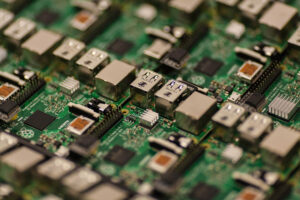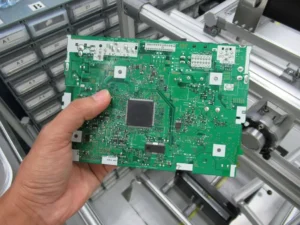Today, printed circuit boards are still the primary method of assembly in all types of electronic devices and systems. It has been proven that even if the circuit schematic is designed correctly, an improperly designed PCB can have a negative impact on the reliability of electronic devices. For example, if two thin parallel lines on the printed circuit board are close together, a delay will be formed in the signal waveform and reflected noise will be formed at the end of the transmission line. Therefore, care should be taken to use the correct approach when designing printed circuit boards.
I. Ground design
In electronic devices, grounding is an important method of controlling interference. Most interference problems can be solved if grounding and shielding are used correctly in combination. The grounding structure in electronic devices is roughly system ground, enclosure ground (shield ground), digital ground (logic ground), and analog ground. The following points should be noted in the grounding design:
1, Correctly select single-point grounding and multi-point grounding In low frequency circuits, when the signal operating frequency is less than 1MHz, the inductance between its wiring and devices has less influence, and the loop current formed by the grounding circuit interferes with it more, so one point grounding should be used. When the signal operating frequency is greater than 10MHz, grounding impedance becomes very large, at this time should minimize the grounding impedance, should be used near the multi-point grounding. When the working frequency in 1 ~ 10MHz, if using a point grounding, its grounding length should not exceed 1/20 of the wavelength, otherwise, multi-point grounding method should be used.
2. Separate digital and analog circuits boards with high speed logic circuits and linear circuits should be separated as much as possible, while the ground of both should not be mixed and connected to the power side ground separately. The ground area of the linear circuit should be as large as possible.
3. Try to thicken the ground wire If the ground wire is very thin, the ground potential is changing with the current, resulting in unstable timing signal levels and poor noise immunity in electronic devices. Therefore, the ground wire should be as thick as possible so that it can pass the three allowable currents located on the printed circuit board. If possible, the width of the ground wire should be greater than 3mm.
4. When designing a grounding system for a printed circuit board consisting of only digital circuits, making the ground wire a closed loop can greatly improve noise immunity. The reason is: there are many integrated circuit components on the printed circuit board, especially when it comes to more power-consuming components, due to the limitations of the ground thickness, it will generate a large potential difference at the ground junction, resulting in a decrease in noise immunity, if the ground structure is made into a loop, it will reduce the potential difference value and improve the noise immunity of electronic equipment.
IV. Printed circuit board size and device configuration
The size of the printed circuit board should be moderate, too large when the printed lines are long, the impedance increases, not only noise immunity decreases, the cost is also high; too small, it is not good heat dissipation, while vulnerable to interference from neighboring lines.
In the same device arrangement as other logic circuits, mutually related devices should be placed as close together as possible to obtain better noise immunity. Clock generators, crystal oscillators and CPU clock inputs are all prone to noise and should be placed closer to each other. Devices prone to noise, small current circuits, high current circuits, etc. should be placed as far away from the logic circuit as possible, if possible, a separate circuit board should be made, this is very important.
V. Thermal design
From the perspective of facilitating heat dissipation, the printing plate should preferably be mounted upright, the distance between the plates should generally be no less than 2cm, and the arrangement of the devices on the printing plate should follow certain rules:
● For devices with free convection air cooling, it is best to arrange the ICs (or other devices) in a longitudinal fashion; for devices with forced air cooling, it is best to arrange the ICs (or other devices) in a long horizontal fashion.
● The devices on the same printed board should be arranged as much as possible according to their heat generation size and heat dissipation degree partition, with devices that generate little heat or have poor heat resistance (such as small signal transistors, small-scale integrated circuits, electrolytic capacitors, etc.) placed in the uppermost stream (at the entrance) of the cooling airflow, and devices that generate a lot of heat or have good heat resistance (such as power transistors, large-scale integrated circuits, etc.) placed in the The most downstream of the cooling airflow.
● In the horizontal direction, high-power devices are placed as close to the edge of the printed board as possible to shorten the heat transfer path; in the vertical direction, high-power devices are placed as close to the top of the printed board as possible to reduce the impact of these devices on the temperature of other devices when operating. ● The devices that are more sensitive to temperature are best placed in the area with the lowest temperature (such as the bottom of the device), never place it directly above the heat generating device, and multiple devices are best laid out in a staggered horizontal plane.
● Heat dissipation from printed circuit boards in devices relies heavily on air flow, so it is important to study the air flow path when designing and configure the device or printed circuit board appropriately. Air always tends to flow where there is less resistance when it flows, so when configuring devices on a printed circuit board, avoid leaving a large open area in a certain region. The same should be noted for the configuration of multiple printed circuit boards in the entire machine.
A great deal of practical experience has shown that using a reasonable device arrangement can effectively reduce the temperature rise of printed circuits, resulting in a significant reduction in device and equipment failure rates.
The above are just some general principles of printed circuit board reliability design. The reliability of printed circuit boards is closely related to specific circuits, and the design does not still need to be handled accordingly according to the specific circuits in order to maximize the reliability of the printed circuit boards.















